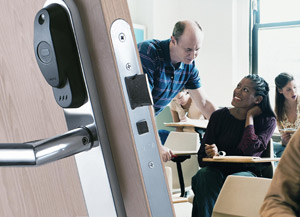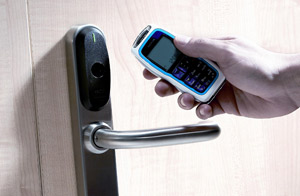Security is now part of the mainstream in day-to-day life at most further education facilities with access control rapidly becoming the fastest growing technology as older, more basic systems are replaced. Marc Handels, Marketing & Sales Director for SALTO Systems Ltd, looks at how security on campus is changing and how access control manufacturers are responding to develop systems to keep pace with their education customers ever more complex requirements.
When it comes to security, access control often as part of an integrated package, is now an essential part of everyone's life on campus from the newest fresher up to the chancellor of the university. It provides a means of authenticating identity, securing valuable assets, retaining important and sensitive information and ensuring personnel security, health and safety. So why do universities need access control as part of their security?
Traditionally universities are very open places, with students, staff and visitors moving freely around the campus and where liberty in all its aspects, including liberty of movement, is crucial. Access control, therefore, is usually an all-embracing title applied to many integrated and dynamic areas such as personnel identification (students, professors and staff), building and door access, communications, biometric security, IT/computer/laboratory access and security and fire prevention/protection.  The trick is to find a balance between preserving the liberty of movement whilst protecting people and goods through the use of a highly flexible locking system.
The trick is to find a balance between preserving the liberty of movement whilst protecting people and goods through the use of a highly flexible locking system.
The main security issue in almost all places of further education, from the newest college to the oldest university is still mechanical key control. By using old-fashioned mechanical locks and keys that are cumbersome to control, time consuming and expensive to replace if key security is breached, users leave themselves open to all sorts of potential problems. And of these, there is one problem in particular - mechanical keys are easy to copy with no questions asked in any high street key cutting bar. This can lead to potential security gaps and even liability issues.
So what's the solution? Access control in its traditional (hardwired) form is only a practical answer for a very small number of doors, as the complexity of installation and sheer volume of wiring usually made it a prohibitively expensive option. As an alternative therefore universities are demanding a solution that can cope with as many doors as possible, i.e. for student housing, main entrance ways, lecture facilities and other parts of the campus etc, but they want it at affordable prices as their number one priority security issues aside is and will always remain investing in educational resources.
Features and benefits
Therefore what are the special features universities should look for in a good access control system?
One of the main objectives of a good access control system should always be to reduce the time needed to manage it, without the loss of functionality, flexibility, control and security.
To achieve this most universities will need a central access management software system that can control access activities from several different work places, or even different faculties, with all the access doors being either on-line or stand alone.
Some of the earlier electronic stand alone locks struggled to gain acceptance over the mechanical locks they were supposed to be replacing. Yes the new locks were stand alone, but the programming they required still had to be done manually so for many users there were not enough advantages to encourage a switch away from mechanical locking. However that's now all changed with the introduction of new electronic lock and software developments.
 Now stand alone also means networked. Utilising the concept of distributed intelligence, the use of highly secure read/write credentials and on-line "hot spots" a system can allow users to make all the changes they want while eliminating the need to physically walk around a site updating locks with a hand held programmer.
Now stand alone also means networked. Utilising the concept of distributed intelligence, the use of highly secure read/write credentials and on-line "hot spots" a system can allow users to make all the changes they want while eliminating the need to physically walk around a site updating locks with a hand held programmer.
Such software can manage up to 60,000 users and up to 60,000 doors in a single system and provides 90% of what users get from a wired on-line system at the cost of a stand alone system, allowing them to manage their access control requirements in a secure and comfortable way.
This eliminates the need to replace locks when key security is breached due to the loss or theft of keys and can seamlessly integrate with an existing IT system to allow keys and locks to be updated, restricted or deleted remotely. Also campus applications will typically include 8 sets of automatic locking and unlocking timers built into the lock handles as they allow for automated free access and restricted access to common areas through the day, while a timed toggle setting for classrooms allows lecturers to unlock doors for lectures or tutorials knowing that the door will automatically re-lock at the end of the day if it is left open.
 Future trends
Future trends
Having made the decision to upgrade from mechanical systems to electronic access control, most universities as befits their further education status have learned quickly and are now making increasingly complex demands of their security systems, ensuring manufacturers have to keep innovating to deliver the products the market now regards as the benchmark standard.
For instance the multi-application demand is increasing and card systems have to be secure and encrypted. And, very soon we will start to see the implementation of NFC (Near Field Communication) technology that will allow students to use their mobile phones on campus as interactive credentials removing the need for traditional access cards. These and other developments will have a huge impact for access control ensuring that smart access on campus will continue to grow and evolve, both culturally and technically.
 Marc Handels
Marc Handels
Marketing & Sales Director
SALTO Systems Ltd

















